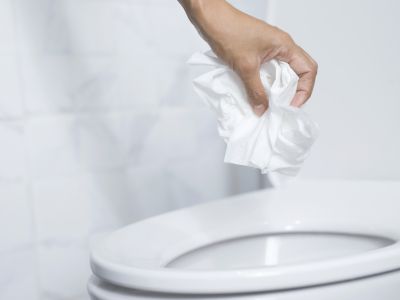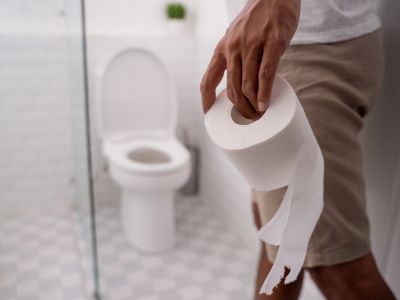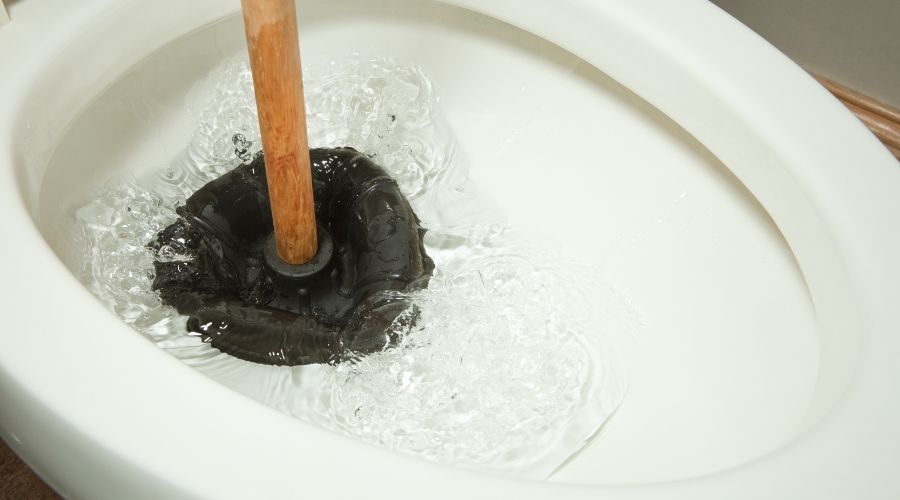Why Is the Toilet Always Clogging?
A clogged toilet is never fun to deal with. At best, it takes a few minutes with a plunger to get things back to normal. At worst, it becomes an hours-long ordeal, with nasty water overflowing onto the floor and a plumber working with a drain snake to unclog it. Either way, it’s not a pleasant experience.
If the toilet clogs repeatedly, it can be frustrating and downright maddening. In some cases, there can be an underlying issue, like a clogged sewer line. But most times, toilet clogs are preventable. This article will explain what can cause clogged toilets and sewer lines and how homeowners can avoid them.
Be Careful What Gets Flushed
 Wherever there’s a toilet clog, the culprit may be non-flushable items that were flushed and have gotten stuck in the drain pipe or sewer line. Some such items that shouldn’t get flushed include:
Wherever there’s a toilet clog, the culprit may be non-flushable items that were flushed and have gotten stuck in the drain pipe or sewer line. Some such items that shouldn’t get flushed include:
- Paper towels
- Napkins
- Tissues
- Sanitary wipes (even the ones labeled as “flushable”)
- Diapers
- Feminine hygiene products
- Cotton balls
- Cotton swabs
- Dental floss
- Cat litter
The problem with these items is that they don’t break down in water like toilet paper is designed. Instead of disintegrating, they stay put and cause a clog or backup when they get lodged in a pipe.
Even if they don’t get stuck in the home’s drainage system, these items can cause problems downstream at wastewater treatment facilities. To be safe, homeowners should avoid flushing anything down the toilet except toilet paper.
Don’t Flush Too Much Toilet Paper At Once
 Even though toilet paper is the only material specifically designed to be flushed safely down the toilet, it can still contribute to toilet clogs if too much is flushed at once.
Even though toilet paper is the only material specifically designed to be flushed safely down the toilet, it can still contribute to toilet clogs if too much is flushed at once.
This is simply because a large wad of toilet paper can get stuck in a curve or jam up against residue inside the pipe. It will then form a dense clump that water won’t be able to penetrate.
Fortunately, this problem is easy to avoid. One option is to use less toilet paper, but sometimes, that’s easier said than done. Installing a bidet can help reduce the amount of toilet paper needed and even improve cleanliness.
Or, if homeowners need to use more toilet paper, they can flush multiple times as they go to minimize the volume of toilet paper flushed at one time. This method uses a little more water, but between that and a clog, the tradeoff is worth it!
Keep the Sewer Line Clean
Some toilet clogs originate downstream, in the home’s main sewer line. All of the home’s drains lead to the sewer line. A clogged sewer line will affect every toilet and drain in the home, starting with the ones on the bottom floor. This is why homeowners might toil with a plunger for what seems like an eternity and see no change—the clog is too far down and too stubborn for a plunger to make a difference.
Clogs in sewer pipes can be caused by grease buildup (from pouring grease and oil down the kitchen sink), stubborn materials (like those listed above), invading tree roots, a collapsed or damaged sewer line, and more.
To avoid sewer line clogs, homeowners can avoid pouring grease and putting food waste down the drains, only flushing toilet paper, installing root barriers around their sewer pipes, and scheduling preventive drain cleaning with a professional plumber.
In the event of a clogged sewer line, homeowners should immediately call a professional for drain cleaning. They have the tools and training to diagnose and fix the problem safely without making matters worse!
About VanDerBosch Plumbing Inc.
For over 17 years, VanDerBosch Plumbing Inc. has been one of Chicago’s highest-rated plumbers. They provide competitive upfront pricing, excellent warranties, a 100% satisfaction guarantee, and never charge service fees. Call them for drain cleaning and clogged toilet repair in Roselle, IL.

